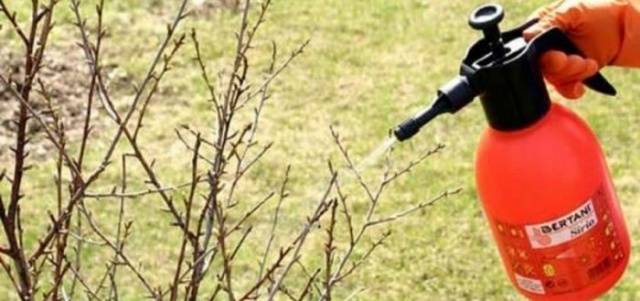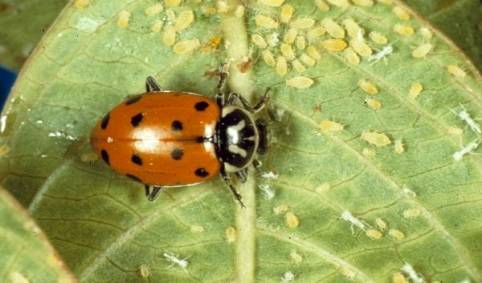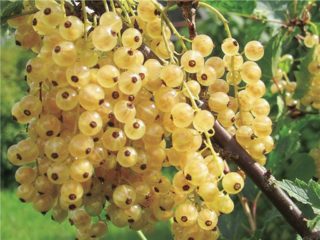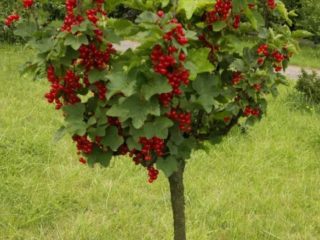In terms of the number of species (about 2200 in Europe alone), aphids occupy one of the leading places among all existing insects. Individuals of aphids of different species differ from each other in body color, size, and most importantly, in the host plant on which they parasitize. Aphids feed on the juice of young shoots and leaves, piercing them with their sharp proboscis located on the front of the head. This feeding of the aphids promotes the secretion of large amounts of honeydew - a sticky and sweet substance, which, in turn, attracts ants that feed on it. Ants always find colonies of aphids on currants, protect and protect them from insects that are not averse to eating the pest. Gardeners not only have to contend with aphids, but also with ant infestations.
Types of currant aphids
Currants are the favorite berry bush of many gardeners; in their gardens they grow different types and varieties of these wonderful and healthy berries. The first place in distribution is occupied by black currants, followed by red and yellow (white).In spring and early summer, when the bushes form young shoots and actively increase the green mass of leaves, they are in danger of being invaded by aphids, which like to settle closer to young growth.
Aphids on black currants
Name: shoot gooseberry (currant) aphid.
Characteristic: body length from 2 to 2.5 mm, green color, after the formation of wings, the head and abdomen become black, in an adult female the cover is yellow-orange, the body of males is black.
Peculiarities: female aphids are capable of laying eggs (black, shiny, oblong) 5-10 times per season, the last clutch overwinters on currant branches at the very base of the buds.
How to fight: manually trim all the top growths of the currant, where the bulk of the aphids have settled, spray the bushes several times with chemical or biological preparations, use folk remedies against aphids, feed the currants if they need additional fertilizer.
Aphids on red currants
Name: gall leaf aphid (red currant).
Characteristic: the body of the red gall aphid reaches a length of no more than 2.5 mm, it is painted in a pale yellow-green color, the surface of the body is covered with sparse hairs, the productivity of one female aphid is more than 200 eggs per season.
Peculiarities: colonies of gall aphids live on the back side of currant leaves, pierce them and suck out the juices, and the plant tries to heal the puncture sites on its own, as a result, growths in the form of galls are formed on the leaves - multi-colored (usually red-brown) formations, on the surface of the leaf they look like spherical swellings.
How to fight: in the first days, the reproduction of aphids on currants is inhibited by tearing off leaves or cutting off the tops of young shoots, where the main female with the “family” lives; if you’re lucky, she will disappear along with the removed parts of the plant. In the future, chemical and biological preparations and products prepared according to folk recipes are used.
Aphids on golden (white, yellow) currants
White currants, like red ones, are preferred by the same gall aphid, which reproduces only on colored types of currants. Its main characteristics and features are described above (see photo and section: aphids on red currants). Control measures are also identical.
Pest control
Each gardener with experience has his own favorite and time-tested method of fighting aphids on different types of currants; in this fight they pay a lot of attention to the prevention and protection of the plant, doing everything to prevent aphids from settling on their currants, bypassing, or, more precisely, flying around her side. We completely agree with experienced people, and we will start with preventive measures, we will advise novice amateurs on how best to protect currant bushes even before the threat of aphid invasion.
Prevention and protection
Many gardeners know what prevention is in crop production, so they everywhere and constantly apply it in practice. For beginners, it is worth explaining that all measures aimed at protecting plants from the occurrence of a particular disease, as well as from the invasion of harmful garden insects, are called preventive measures, which should not be neglected when caring for plants in gardens and vegetable gardens.
The first stage of currant protection against aphids: in early spring, all trees and shrubs in the garden, including currants, are treated with fungicides - chemical or biological preparations that can protect plants from fungal, viral, bacterial diseases, destroy pests, that is, protect currant bushes not only from aphids, but also others dangerous arthropods. The same means are used to disinfect the soil. The eggs of many insect pests overwinter in the ground or on the plants themselves; by treating, you will destroy more of them.
The second stage of currant protection against aphids: In the spring, repellent plants are planted near currants, which repel aphids from fruit bushes. Such plants that protect currant bushes include:
- onion garlic;
- spicy herbs (parsley, basil, mint, coriander);
- other plants with a pungent odor (tansy, marigolds, tomatoes).
Planting repellent plants not only protects currant bushes from pests, but also brings benefits as excellent culinary seasonings, and if they are flowers, then they perfectly complement the secluded corners of the garden with their color, in the center of which healthy currant bushes with beautiful bright berries grow.
The third stage of currant protection against aphids: before planting repellent plants, currants need to be fed, because after a long winter, the reserves of nutrients in the soil have been depleted, and a weakened bush will not be able to withstand the attack of aphids. At this time, that is, in early spring, the bulk of all the fertilizers required by the plant for the summer period are applied: manure, compost and dry mineral fertilizers are poured under the roots of the plant, the soil is dug up and loosened.Before flowering begins, foliar feeding of currants is carried out by spraying foliage and shoots with nutrient solutions. We will tell you what these solutions are a little later.
Treatment with drugs
Preventive measures are effective and efficient, but our currants are not immune from accidents, especially if there are careless neighbors near your site who did not process their plantings of currant bushes in a timely manner. Let's say that gusts of wind or ants brought aphids into your garden from a neighbor's plot, and the hated aphid appeared on the young growths of berry bushes. Hoping that you have protected the currants in the spring, you may not immediately notice that aphids are eating them, and this is not the first day. It is still possible to save currants, but now it is impossible to do without the use of chemical or biological products, as well as without household household products or infusions and decoctions prepared according to folk recipes.
- Chemicals: Karbofos, Aktara, Kinmiks, Tanrek.
- Biological products: Fitoverm, Bitoxicillin, Iskra-BIO. Biotlin, Antiant (from ants).
- Household products: ammonia, tar or laundry soap, soda, kerosene.
- Decoctions and infusions: from celandine, onions, wood ash, tobacco, potatoes (see recipes below).
Spraying currants should be carried out in the following way:
- time - evening hours;
- weather - calm, windless;
- spraying - spray solutions from the sprayer on both sides of the leaves;
- number of currant treatments - regularly, every 10-12 days, until all aphid colonies disappear.
Of all the types of currants, it will be easiest to get rid of aphids on black currants; they are more resistant to aphid attacks; after 2-3 sprayings, the aphids completely disappear from its leaves.
Resuscitation (scalding with boiling water)
Many gardeners have mastered the original method of saving currant bushes. In early spring, when the snow in the areas has not yet completely melted, they carry out shock resuscitation of dying currant bushes, dousing the bushes with boiling water or hot water at a temperature not lower than +70°C. This treatment of plants, as experienced gardeners note, allows you to save currants not only from aphids and many other harmful insects. Under the influence of high temperatures, all pathogens of viral and bacterial diseases die.
Dousing currants should be carried out in the morning or afternoon on a sunny day, so that the bushes dry in the sun after such a shower and do not become frozen. A hot shower does not guarantee a 100% cure for an overly affected currant bush, but in 90% of cases the plant returns to full life and produces a decent harvest of berries in the coming season.
Folk recipes
For those gardeners who are not ready to use pesticides on their plots, we have prepared several recipes for preparing products that are safe and harmless to humans and the environment:
- onion infusion: pour 250-300 g of chopped onions into a bucket of water (you can take unpeeled onions), close the lid, leave for 1-2 days, strain, spray 2-3 times;
- ash decoction: boil a bucket of water with 500 g of wood ash, after 2 hours add 50 g of laundry or tar soap, mix and strain through cheesecloth so that small particles do not clog the sprayer mesh, process the currants 2-3 times;
- infusion of tobacco leaves: Pour boiling water (5 liters) over 300-400 g of tobacco leaves, close the container tightly with a lid, leave until completely cool, filter, spray currant bushes 2-3 times per season.
- infusion of celandine: chop fresh branches of celandine into pieces up to 5 cm, fill a bucket halfway with them, pour boiling water or hot water (+ 70°C), cool, spray the currants several times at intervals of 7 days.
The use of folk remedies does not threaten the environment, so they can be used in any growing season of the plant, you can alternate between different decoctions and infusions so that aphids cannot adapt (get used to) any one of them, then the fight against aphids can become more effective. A lively and cheerful berry lover talks in the video about her method of treating plants against aphids, watch and smile.
Attracting beneficial insects and birds to the garden
Aphids, sucking juices from plants, supply themselves with many nutrients, in addition, they secrete honeydew that tastes sweet, which attracts predatory insects: ladybugs and their larvae, lacewings and sand wasps. When meeting aphids, they are not averse to feasting on them: crickets, ground beetles, earwigs, spiders, hoverflies.By devouring the harmful aphids on currants, they save the plant.
Rescuers need to be lured with something, so you need to know their habits: earwigs like to hide in wood shavings, which means you need to place a container (box, bucket, pot) with such a shelter next to the currants, hoverflies are attracted by the pungent smell of dill, plant a few bushes near the currants and everyone will be happy.
Many species of birds also destroy aphids by feeding on them and feeding their chicks. To attract birds to your garden, arrange feeders, drinking bowls, and birdhouses. The main types of birds that eat aphids are starlings, titmice, warblers, sparrows and all forest birds. For them, aphids are an excellent supplier of glucose and other carbohydrates. One bird can rid a garden of many harmful insects per day, including up to 200-300 female and male aphids.
By fighting aphid colonies, you also clear the gardens of ants; aphids will disappear from your plots, followed by ants.
Conclusion
Caring for the garden and vegetable garden for most amateur gardeners is not forced work, for them it is a manifestation of their feelings for everything around them, because a person who loves plants cannot but love his family and friends, not care for them the same way as for green pets in the garden. It costs a lot. Native people, Fatherland, Nature - there is nothing more valuable than this, love them and take care of them all your life.
For a complete overview of ways to combat aphids on currants, we have placed useful video clips in a way that is impossible to cover everything in one article. Watch, study, apply. Good luck.

















